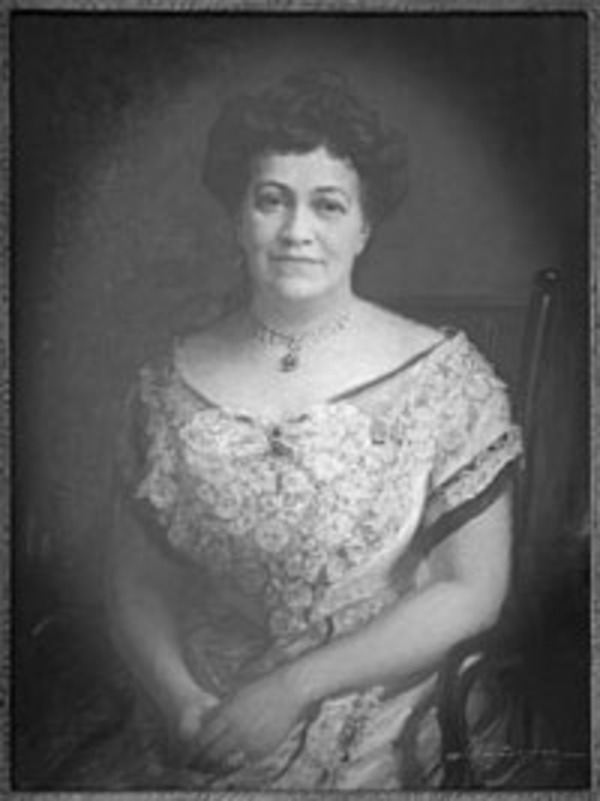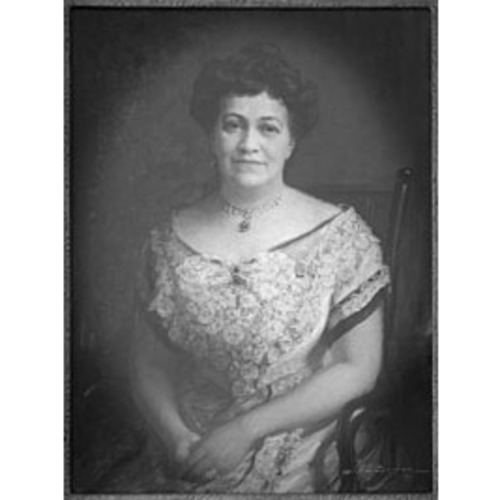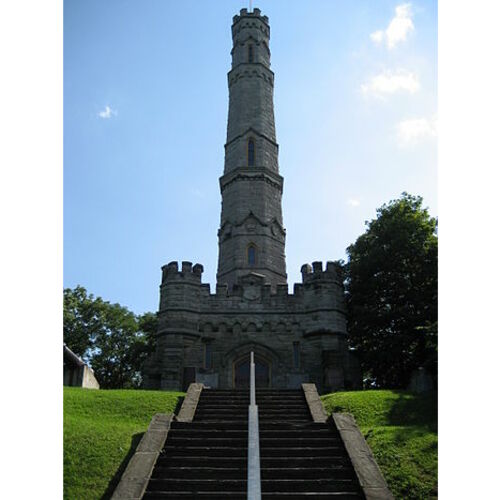
Source: Link
BEEMER, SARA GALBRAITH (Calder), philanthropist; b. 19 Aug. 1846 in Hamilton, Upper Canada, daughter of Levi Beemer, a jeweller and watchmaker, and Ann Eliza Gage; m. 22 Dec. 1869 John Calder (d. 1901) in Buffalo, N.Y., and they had seven sons and two daughters; d. 16 March 1914 in Hamilton.
Educated in Hamilton, Sara Beemer married John Calder, a clothier, whose prominence helped give her the opportunity to become involved in the organized movements and philanthropies of her Anglo-Canadian culture. She was a granddaughter of James Gage*, the War of 1812 veteran who owned the homestead at Stoney Creek that had been occupied by the Americans in a major battle on 6 June 1813, and she had grown up under the influence of the heroic view of loyalism. A founding member of the Wentworth Historical Society in 1889, she opposed the recommendation of an all-male committee that the battle be commemorated by the erection of a monument on Smith’s Knoll, where the British had successfully stormed the Americans’ artillery. The knoll, situated across the road from the Gage property, lacked the prominence of the hill to the rear of the homestead. Mrs Calder envisioned building on this hill a monument whose size and visibility would awaken the Canadian historical consciousness and communicate the aspirations of the imperial ideal.
As first president of the society’s ladies’ committee, formed in May 1895, Calder proved her administrative capacity in November when she organized a week-long exhibition which raised over $1,000 for a history museum in Hamilton. This profit became the committee’s ace in the dispute over the location of the memorial. Calder and some of her associates, convinced that the men were short-sighted in their choice of sites for both the monument and the museum, took control of the money. Their action caused such friction that the ladies’ committee, at Calder’s urging, dissociated from the parent society and incorporated itself in May 1899 as the Women’s Wentworth Historical Society. Calder had previously purchased four acres of the Gage farm, paying $900 down and assuming a mortgage for $1,000. She then offered the government of Canada, on behalf of the women’s society, land for a monument. Through the influence of her friend and ally in the House of Commons, Andrew Trew Wood*, whose first wife was also a granddaughter of James Gage, the minister of militia and defence, Frederick William Borden, accepted the offer. Calder subsequently placed the property in trust for the women’s society until the government required the land.
The Wentworth Historical Society protested that a “great historical mistake” would be made should the government erect a monument on a site that was not linked with the turning-point in the engagement. As a result, deputy minister Louis-Félix Pinault ordered an investigation to determine “the centre of the battlefield.” Calder reacted to this distressing news by rallying her supporters to convert the property into a park and restore the homestead. On 21 Oct. 1899 Lady Aberdeen [Marjoribanks*] opened Stoney Creek Battlefield to the public. The Women’s Wentworth Historical Society was the first historical society in Canada to purchase and turn over to the public a national heritage. The following year Borden visited the park and subsequently he encouraged Calder in the belief that his department would carry out its original decision.
Over the next several years Calder’s dynamic leadership propelled the society, which had no revenue except membership fees and a small grant from the Ontario government, into a series of successful fund-raising ventures to free the property from encumbrance. By October 1907 it had paid off the mortgage. The following July Borden announced a grant of $5,000 to the WWHS.
The award fanned the smouldering antagonism between the men’s and women’s societies. Consequently Borden decided not to release the money until both sides had reached an understanding. The men, who were still planning a monument for Smith’s Knoll, agreed to cooperate but Calder rebuffed them until she was compelled to come to the table by deputy minister Eugène Fiset*. The two sides met on 6 Jan. 1909. In the end Calder got what she wanted on the understanding that the men’s monument would be erected first and that the women would assist them in raising $1,500 towards its cost.
Assured that the federal grant would be revoted, she invited Lady Grey, wife of Governor General Lord Grey, to turn the first sod on her society’s site in May. In February 1910 Calder purchased an additional 13 acres of the original Gage patent, adding them to the park. By November 1911 the $5,000 had been spent and work on the monument there ceased. When Calder requested another grant, the militia department, which had already erected monuments on the battlefields of Châteauguay, Crysler’s Farm, and Lundy’s Lane, decided to complete the work as a government project. Title to the monument, however, remained with the WWHS. On 6 June 1913, the centenary of Stoney Creek, a magnificent stone tower was unveiled before an estimated crowd of 8,000 people. The ideological impact of the tower was reinforced by the inscription on the monument, which claimed the battle had been “the decisive engagement” of the war and the turning-point in the defence of “British liberty of which Canada is the inheritor.”
Calder’s interest in Canada’s historical tradition found an outlet in other projects. She was, for instance, an active member of the Hamilton branch of the Quebec battlefields commission, formed in 1908. Upon the death of Queen Victoria in 1901, she had instituted a committee which led to the erection of a statue to her memory in Hamilton. In 1910 she started a movement for a statue of the recently deceased King Edward VII, but the public favoured a more practical demonstration of admiration and endorsed a proposal for a children’s hospital.
Besides her historical and imperial commemorative projects, Calder was vice-president of the Boys’ Home in Hamilton and for 32 years a member of its committee of management, vice-president of the Local Council of Women, a member of the women’s auxiliary of the Hamilton branch of the Victorian Order of Nurses, and a member of the auxiliary board of the Hamilton Health Association. At Central Presbyterian Church she served as a Sunday-school teacher and vice-president of the Home Mission Society. In 1894 she organized the local branch of the Women’s Art Association of Canada. Calder died in 1914 and was survived by a daughter and a son.
A woman of strong resolution, Sara Calder acted with decision and opposed with firmness. Her strength of character won her many male allies, among them Sir John Morison Gibson* and John Strathearn Hendrie*, whose wives were vice-presidents of the WWHS. Though she rejected the female tradition of deferring to men, she was not an advocate of women’s rights. Her defiance of the male-dominated Wentworth Historical Society is a perfect example of how the bounds which circumscribed women’s lives were undergoing transformation as Canada changed from a rural to an urban society.
AO, RG 22-205, no.8816. HPL, Scrapbooks, H. F. Gardiner, vols.113, 206; Times, vol.1, pt.2; Victorian Hamilton, vol.14; Women’s Wentworth Hist. Soc. NA, RG 2, P.C. 1055, 21 May 1910; P.C. 2557, 12 Sept. 1912; RG 22, 904, file 357-2, pt.2; RG 24, 6559, file HQ 899-11, pts.1–2. Wentworth Land Registry Office (Hamilton, Ont.), Abstract index to deeds, Saltfleet Township, concession 4, lot 26. Hamilton Herald, 16, 19 March 1914. Hamilton Spectator, 25 Dec. 1869, 1899–1913, 16 March 1914. Buffalo city directory (Buffalo, N.Y.), 1868–70. Can., House of Commons, Debates, 1907/8: 13177; Parl., Sessional papers, 1910, no.5a; 1912, no.4. Genealogical and historical records of the Mills and Gage families, 1776–1926, 150 years, comp. Stanley Mills (Hamilton, 1926). “History of Women’s Art Association,” Art-i-fact (Hamilton), 2 (1974), no.1: 4 (copy in HPL). Gerald Killan, Preserving Ontario’s heritage: a history of the Ontario Historical Society (Ottawa, 1976). [Elizabeth Lyle], Hamilton Local Council of Women, 1893–1919, a record of twenty-six years of activity (Hamilton, 1920; copy in HPL). “Military fête” and “Monument sites, with correspondence and papers relating thereto,” ed. J. A. Griffin, in Wentworth Hist. Soc., Journal and Trans. (Hamilton), 2 (1899): 155–59 and 3 (1902): 91–101, respectively. Ont., Statutes, 1899, c.108, sect.10. Ontario Hist. Soc., Annual report (Toronto), 1899: 54–55. RSC, Trans., 2nd ser., 6 (1900), proc., app.C: xlviii–l; 7 (1901), proc., app.B: xliii–xliv. C. J. Taylor, Negotiating the past: the making of Canada’s national historic parks and sites (Montreal and Kingston, Ont., 1990). Wentworth Hist. Soc., Ladies’ committee, Souvenir book and programme for military encampment, November, 1895, ed. M. J. Nisbet, assisted by F. L. Davis (Hamilton, [1895]). Women’s Wentworth Hist. Soc., Ye pioneers of one hundred years ago . . . , ed. M. J. Nisbet ([Hamilton, 1900]).
Cite This Article
Peter Hanlon, “BEEMER, SARA GALBRAITH (Calder),” in Dictionary of Canadian Biography, vol. 14, University of Toronto/Université Laval, 2003–, accessed December 30, 2025, https://www.biographi.ca/en/bio/beemer_sara_galbraith_14E.html.
The citation above shows the format for footnotes and endnotes according to the Chicago manual of style (16th edition). Information to be used in other citation formats:
| Permalink: | https://www.biographi.ca/en/bio/beemer_sara_galbraith_14E.html |
| Author of Article: | Peter Hanlon |
| Title of Article: | BEEMER, SARA GALBRAITH (Calder) |
| Publication Name: | Dictionary of Canadian Biography, vol. 14 |
| Publisher: | University of Toronto/Université Laval |
| Year of publication: | 1998 |
| Year of revision: | 1998 |
| Access Date: | December 30, 2025 |




